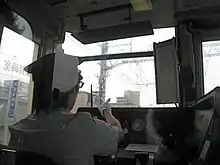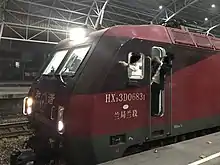Pointing and calling
Pointing and calling is a method in occupational safety for avoiding mistakes by pointing at important indicators and calling out the status. It is common in Japan and railways of China. It is sometimes referred to by its Japanese terms, shisa kanko (指差喚呼), shisa kakunin kanko (指差確認喚呼) or yubisashi koshō (指差呼称), and by its Chinese name, "指差呼唤 (Pinyin: zhǐchā hūhuàn)". Making large gestures and speaking out the status helps keeping focus and attention. The method was first used by train drivers and is now commonly used in Japanese industry. It is not common in other countries, though it is used in the New York City Subway system and many other systems built in Chinese standards, for example Addis Ababa-Djibouti Railway. It is recommended by the Japan Industrial Safety and Health Association (JISHA, 中央労働災害防止協会),[1][2] and a part of "Railway Management Regulations" in China.[3]



Pointing and calling requires co-action and co-reaction among the operator's brain, eyes, hands, mouth, and ears.
History
The method originated in Japan in the early 1900s, with train drivers calling out the status of signals. Back in those days steam locomotives were common in use, with loud noises, steam and smoke making the cooperation between the two drivers difficult, and also making rail journeys dangerous. Drivers had to call out loudly to hear each other. The pointing was added a few decades later.[1] During the Japanese occupation of China and the South Manchuria Railway's operation, the system was introduced to China, which slightly changed to fit the Chinese Railway system.
Asia
The method is widely used in East Asia countries, especially in dangerous works such as elevator maintenance and railway operations. The Chinese variant became much more complex including pointing (using both forefinger and middle finger instead of forefinger only in Japan, used when checking signals, doors, speed and other major aspects) and caution (bending the right elbow by 90° and lifting the forearm upright, used when a checking procedure is finished or caution signals).[3]
In Japan the pointing and calling has become a part of the railway culture, and is featured in many events like the opening of a new railway company, such as the departing ceremony of Osaka Metro.
North America
In North America, transit workers perform a similar procedure, known as "point and acknowledge".
New York City
In the MTA, before opening the train doors, subway conductors are required to point to a black-and-white striped board located opposite of the conductor's window every time when a train pulls into a station. The procedure was implemented in 1996 after a series of incidents where doors opened in the tunnel. The procedure shows that the conductor is paying attention. If the conductor cannot see the striped board, they are not permitted to open the doors.[4]
Toronto
In the TTC, before opening the train doors, subway conductors are required to point to a green triangle installed on the platform wall opposite of the conductor's window every time when a train pulls into a station. The procedure was implemented after a series of incidents where conductors opened the doors on the wrong side of the train. The procedure is used to focus the conductor's attention.[5]
Streetcar operators are required to confirm track switch alignments by stopping at a switch, pointing to the switch with their index finger, and then proceed. This is done to focus the operator's attention to ensure that the streetcar does not go to a different route.[5]
Effectiveness
A 1994 study by the Railway Technical Research Institute showed that pointing and calling reduced mistakes by almost 85 percent when doing a simple task.[1]
References
- Gordenker, Alice (October 21, 2008). "JR gestures". The Japan Times. Retrieved 2008-12-05.
- "Terminal Evaluation - Latin America and the Caribbean". Japan International Cooperation Agency. Archived from the original on 2011-07-16. Retrieved 2008-12-05.
- "铁路技术管理规程(电子版) - 百度文库". wenku.baidu.com. Retrieved 2019-01-19.
- "MTA | news | Subway Conductors Point the Way to Safety". www.mta.info. Retrieved 2019-04-30.
- "2014 TTC APTA Audit" (PDF). TTC.ca. September 11, 2015.
Further reading
- "田辺肇 "危険予知活動実践マニュアル" 1984, Japan Industrial Safety and Health Association
- "今村一郎 "機関車と共に" 1962、ヘッドライト社, page 78
- "神戸鉄道管理局 "機関車乗務員教範" 1913年, pages 259-262
- Kazumitsu Shinoharaa; Hiroshi Naitoa; Yuko Matsuib; Masaru Hikonob (March 2013). "The effects of "finger pointing and calling" on cognitive control processes in the task-switching paradigm". International Journal of Industrial Ergonomics. 43 (2): 129–136. doi:10.1016/j.ergon.2012.08.004.
- "Railway Management Regulations(铁路技术管理规程)" 1992, China Railways
External links
| Wikimedia Commons has media related to Pointing and calling. |
- AllAboutLean.com (Jan 4, 2014). Pointing and Calling Japanese Safety Standard at Railway Companies & Toyota. Youtube.
- "Concept of "Zero-accident Total Participation Campaign"". Japan International Center for Occupational Safety and Health.
- Yosef Lerner (Oct 30, 2013). The New York Subway Signs Experiment. Youtube.
In NYC, subway conductors have to point at a black and white sign to prove that they're paying attention. They do it at every hour, at every stop. It's kind of silly, so we decided to make their day.
- James Albright (Jun 22, 2017). "Adding Japanese 'Shisa Kanko' Techniques To Modern Cockpits". Aviation Week Network.